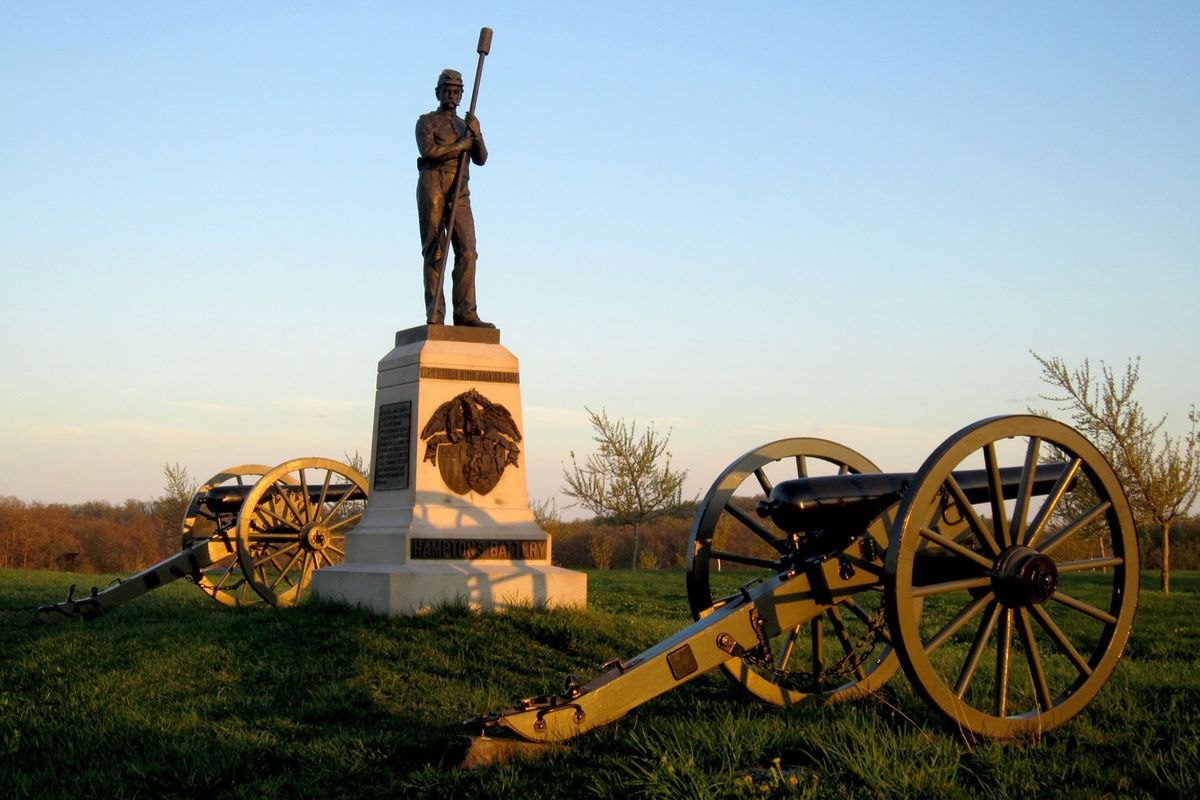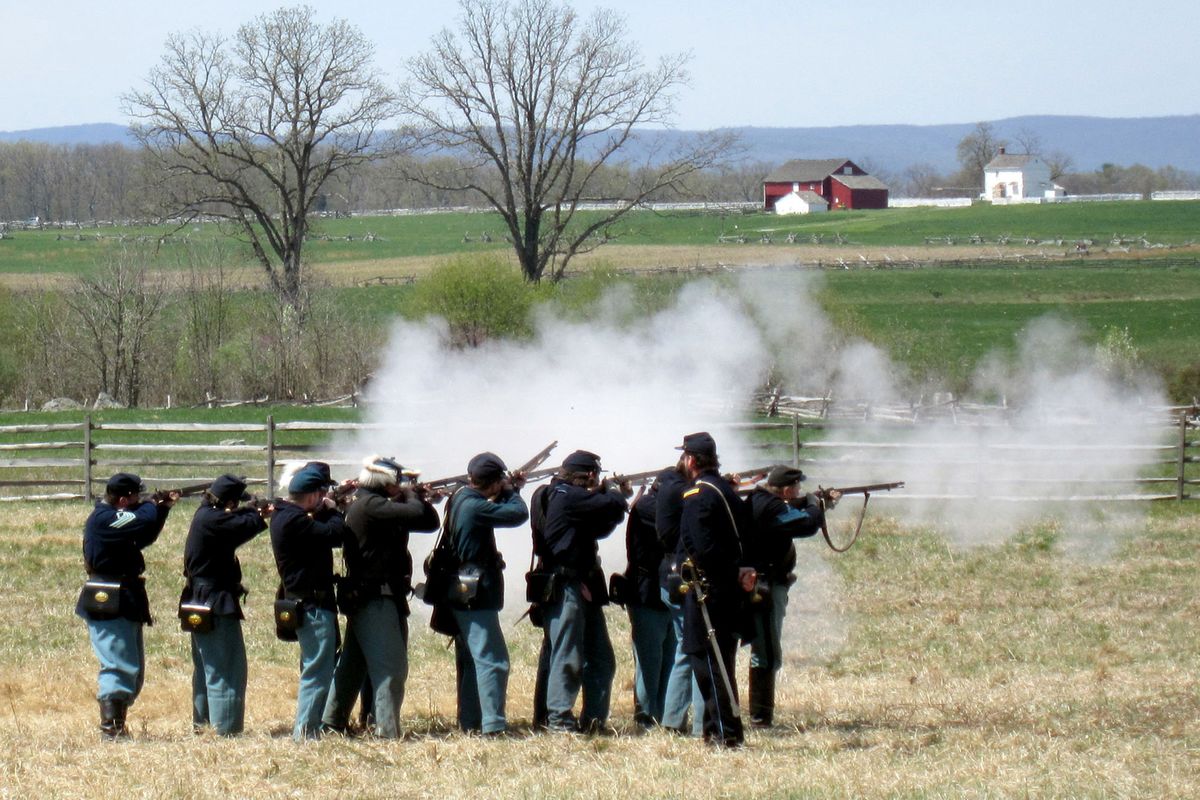Gettysburg commemorates 150 years with plethora of events
A monument to artillerymen provides quiet testimony to the soldiers who fought at Gettysburg, Pa.
GETTYSBURG, Pa. – In July 1863, the 2,400 residents of Gettysburg had little time to prepare for 170,000 Confederate and Union soldiers who advanced on the town. The soldiers clashed in a three-day battle that would paint its streets and pastoral farmlands crimson in the bloodiest encounter of the Civil War.
Today, the town of 8,000 braces for another invasion of as many as 70,000 Americans on July 1, 2 and 3 and a predicted 200,000 during the 150th observance of the Battle of Gettysburg June 28 to July 7. Officials and residents are working hard to be ready for the onslaught.
A sampling of the blow-your-hat-off experiences for Civil War fans brave enough to advance on Gettysburg during this special time: climbing the cupola where Gen. John Buford plotted his strategy while monitoring Confederates advancing on the town, seeing the official casting of President Abraham Lincoln’s face, viewing 3,550 luminaria on soldiers’ graves, joining thousands of visitors in a walk-the-battlefield special observance of Pickett’s Charge, and watching two major re-enactments involving 10,000 men.
Major events include:
• A commemorative ceremony on June 30 called “Gettysburg: New Birth of Freedom.”
• The openings of a “Treasures of the Civil War” exhibit, the Spangler Farm Civil War Field Hospital site and the new Seminary Ridge Museum.
• The Blue-Gray Alliance Re-enactment June 29 and 30 at the Bushey Farm, and the 150th Anniversary Gettysburg National Civil War Battle Re-enactment July 4-7 at the Redding Farm.
In addition, there are many smaller events that will bring the battle and its aftermath into focus. These include the Songs and Stories of a Civil War Hospital, in Gettysburg’s Christ Church June 29 and July 6, and Confederates Take the Shriver House, on July 6.
So anyone considering a visit needs an organized battle plan. Map out your plan of attack, using two handbooks.
The first, the 72-page Gettysburg 150th Anniversary Commemorative Events Guide, details programming by the Gettysburg National Military Park and its partner organization, the Gettysburg Foundation. It will be available at the Visitor Center and other locations in the park.
The second, from the Gettysburg Convention & Visitors Bureau, will be all-inclusive, covering town and county events including the two major re-enactments, a new downtown Gettysburg Independence Day parade and Cashtown’s three-day observance of Lee’s Approach to Gettysburg. It also will cover satellite parking, shuttle routes for the 10-day observance, restroom locations and places to eat.
The printed version will be available at the Convention & Visitors Bureau office and its tourist information tents in town and at satellite parking locations. Although printing isn’t scheduled until mid-June, you can download a complete, calendar-style listing of all the 200-plus events for the 10-day observance at http://www.gettysburgcivilwar150.com. Click on “events.”
Reading the guides’ information will serve as a printed version of reveille. It’s your wake-up call to the challenges to be faced when deciding which events to attend.
“Don’t arrive without a room, if you intend to stay overnight,” said Carl Whitehill, Gettysburg Convention & Visitors bureau spokesman.
Day-trippers shouldn’t have any worries, Whitehill said. Approach Gettysburg via routes 15 or 30 and you’ll encounter electronic signs directing you to satellite parking lots. “Leave your car behind and take free transportation into Gettysburg,” Whitehill advised. “At the in-town depot, you can board trolleys for most of the commemoration’s key observances.”
You will need your car, however, if you’re planning to attend one of the major re-enactments staged on the Bushey or Redding farms. Ample parking will be available on designated farm fields.
Could potential visitors become overwhelmed by so many things to do during the 150th commemoration? “I can’t say I’ve worried about that,” said Cindy Small, spokeswoman for the Gettysburg Foundation, which stages events in conjunction with the national military park.
“We have focused on providing all of the information we could about all of our events, so individuals and families can customize their experience, based on their interests,” Small said. “If they use our guide to do their homework, they’ll know what they want to do when they arrive.”
Besides daily park events for the 10-day observance, the guide also provides maps of park traffic patterns and shuttle routes that will change daily July 1-4, and information about the park’s Visitor Center and other special locations including The George Spangler House, Rupp House and David Wills House.
“We put pressure on ourselves to make this year very special,” said Katie Lawhon, spokeswoman for the national military park. “We’ve added many new ranger programs so there will be plenty for everyone to do.” The expanded programming means visitors will spread out to many sites on the 5,000-acre battlefield.
The huge re-enactments are expected to be the biggest draws, Whitehill said.
Here are more details on some of the other events:
• Ceremony: Make plans to attend the “Gettysburg: A New Birth of Freedom” ceremony, which starts 7:30 p.m. June 30. Highlights: country music star Trace Adkins singing the national anthem, keynote speech by Civil War historian Doris Kearns Goodwin, and a Voices of History reading of eyewitness accounts by soldiers and citizens swept into the battle.
Presented in a natural amphitheater on the battlefield, the dramatic setting includes views of Widow Leister’s Farmhouse and Barn, which served as Gen. George Meade’s headquarters, and Big and Little Roundtop. The evening’s finale invites visitors to join a procession from the amphitheater to the Soldiers National Cemetery to see thousands of luminaries commemorating the Union soldiers who lost their lives in the battle.
• Exhibit: The new “Treasures of the Civil War” exhibit at the Visitor Center museum spotlights 13 leaders of the era – Abraham Lincoln, Jefferson Davis, Robert E. Lee, Ulysses Grant, Meade, John Reynolds, George Pickett, Alexander Webb, William Tecumseh Sherman, George Custer, John Mosby, Frederick Douglass and Clara Barton. It includes 94 personal artifacts.
Besides the casting of Lincoln’s face, a few of the other treasures include a lock of Lee’s hair and the mane of his favorite horse, Traveller; Grant’s sword celebrating his victory at Vicksburg; Pickett’s spur; Meade’s slouch hat and frock coat worn at Gettysburg, and Barton’s hair brush.
“These belongings help tell great stories about these people and help visitors make personal connections with them,” Small said.
• Field hospital site: Spangler Farm, used as a field hospital for 1,900 men during the battle. Although seeing it is free, all visitors must procure a ticket and ride a special park service shuttle to the house and barn. Open 9 a.m. to 6 p.m. July 4, and 11 a.m. to 3 p.m. on Fridays, Saturdays and Sundays on a few summer weekends, the farm is still undergoing restoration.
“You’ll see the barn where Army surgeons set up their operating tables to treat wounds and do amputations and walk the grounds where injured soldiers recuperated” (outdoors and with little shelter, after the barn was full), Small said. “Two hundred died and were buried on the farm.”
• New museum: The new Seminary Ridge Museum will stage preview events June 29 and 30, before its July 1 grand opening, exactly 150 years after it was engulfed in the first day of the Battle of Gettysburg. Located in the former Schmucker Hall at the Lutheran Theological Seminary on Seminary Ridge, it offers in-depth looks at the first day’s battle, Civil War medicine and moral and spiritual debates of the era.
But these major events are only the beginning of the opportunity to explore the engagements and human side of this heart-wrenching battle that led Lincoln to write his Gettysburg Address and marked a turning point in the war that continued for an additional two years.
Among the many programs presented by park rangers, there are overview hikes, key moments covering events at a specific time and day of battle, living history camps and programs and special evening Voices of Battle programs presented by living historians who bring to life the eyewitness accounts of the soldiers and civilians at 7:30 p.m. July 2-4.
The Gettysburg Foundation also has created a sunset bus tour of the battlefield and another that focuses on some of the 400 major works of sculpture placed in the military park to honor the men who fought and died at Gettysburg.
But one of the most anticipated special events involving visitors will be the Pickett’s Charge Commemorative March.
At 3 p.m. July 3, the time and day of Pickett’s Charge 150 years earlier, visitors will be asked to join park rangers to walk the Confederate battle line or stay where the Union Army’s battle line awaited them. When the two groups meet at a stone wall, taps will echo over the battlefield.
Lawhon stresses, “This is not a re-creation. We could never re-create the tragedy and horrors of Pickett’s Charge, which was the last encounter of the battle. Nor would we want to. But walking the ground, listening to taps and envisioning what happened here will be unforgettable.”

